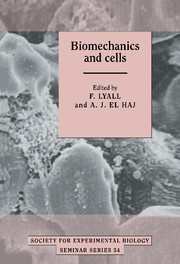Book contents
- Frontmatter
- Contents
- List of contributors
- PART 1 SOFT TISSUE
- Signal transduction pathways in vascular cells exposed to cyclic strain
- Effects of pressure overload on vascular smooth muscle cells
- Effect of increased flow on release of vasoactive substances from vascular endothelial cells
- Modulation of endothelium-derived relaxing factor activity by flow
- Stretch, overload and gene expression in muscle
- Stretch sensitivity in stretch receptor neurones
- Mechanical interactions with plant cells: a selective overview
- Mechanical tensing of cells and chromosome arrangement
- Alterations in gene expression induced by low-frequency, low-intensity electromagnetic fields
- PART 2 HARD TISSUE
- Index
Modulation of endothelium-derived relaxing factor activity by flow
Published online by Cambridge University Press: 19 January 2010
- Frontmatter
- Contents
- List of contributors
- PART 1 SOFT TISSUE
- Signal transduction pathways in vascular cells exposed to cyclic strain
- Effects of pressure overload on vascular smooth muscle cells
- Effect of increased flow on release of vasoactive substances from vascular endothelial cells
- Modulation of endothelium-derived relaxing factor activity by flow
- Stretch, overload and gene expression in muscle
- Stretch sensitivity in stretch receptor neurones
- Mechanical interactions with plant cells: a selective overview
- Mechanical tensing of cells and chromosome arrangement
- Alterations in gene expression induced by low-frequency, low-intensity electromagnetic fields
- PART 2 HARD TISSUE
- Index
Summary
Introduction
The discovery of endothelium-dependent relaxation by Furchgott and Zawadski in 1980 has provided major insights into the mechanisms through which circulating humoral agents, adventitial nerves, and the mechanical forces which result from blood flow influence vasomotor tone. The phenomenon is mediated by a labile endogeneous nitrovasodilator, endothelium-derived relaxing factor (EDRF), which can be detected electrochemically near the endothelial membrane as the nitric oxide radical (NO) (Malinski & Taha, 1992). A constitutive Ca2 +/calmodulin-dependent NO synthase (cNOS), which synthesises NO from a terminal guanidino nitrogen atom of L-arginine by incorporating molecular oxygen into both NO and L-citrulline, is in fact present under normal physiological circumstances in a variety of cell types (Moncada, Palmer & Higgs, 1991). Endothelial cNOS is only c. 50% homologous to rat cerebellar cNOS, its amino terminus possessing structural features which probably confer the ability to respond to mechanical signals resulting from flow (Nishida et al., 1992). These include sites for proline-directed phosphorylation (e.g. by protein kinase A) and a potential substrate site for acyl transferase which may permit attachment to fatty acids (particularly myristic), and thus explain the essentially particulate nature of the enzyme.
An inducible NO synthase (iNOS), whose formation is suppressed by glucocorticoids and other protein synthesis inhibitors, is also expressed in endothelial, vascular smooth muscle and other cell types such as macrophages following immunological stimulation by endotoxin and certain cytokines (Joulou-Schaeffer et al., 1990; Moncada et al., 1991).
- Type
- Chapter
- Information
- Biomechanics and Cells , pp. 61 - 80Publisher: Cambridge University PressPrint publication year: 1994



